Well, I sort of went a little over the top, mainly because I'd opted for a Mantis case, which offers a decent power supply in a very portable (you can even get a matching gigbag for it from Tiptop), inexpensive, and lightweight small case. The Mantis, however, is 2 x 104hp, not a single row, so I figured "ok...let's see if something that really can be a modular stand-out can be cobbled together here, something that gives this user some serious power in a portable cab while still keeping it controllable". Ergo:

OK, so it's not quite so minimal. However, this build not only functions as a modular guitar processing rig, it also has the capability of eliminating the need for several stompboxes. Let's look at this mo'fo...
Top row: first up is the input. Notice that this isn't merely a guitar-in jack. That module also contains the proper level and impedence matching for a guitar-in, plus it has an envelope follower and gate extractor. Envelope followers are the basic circuit in an auto-wah...but in this, you just get an adjustable voltage curve related to the input dynamics which can be sent anywhere as a control voltage. The gate extractor gets set to fire a gate signal when the input level crosses a certain level, so there's a lot of possibilities there, from triggering envelopes to audio 'squaring' the guitar signal. This has two sets of mults associated with it: the active is for splitting/buffering your audio so that it can parallel-feed modules, and the passive's two sections are for distributing the envelope follower and gate.
Then the audio processing chain (although, unlike a normal signal chain in a synth patch, there's no need to serially patch these, hence the active mult): octave divider, wavefolder (CV-able distortion/harmonic folding), Polaris VCF/phaser, EMW Triple Bandpass for three-way swept resonances, a Chronoblob delay (which has an insert point in its feedback path, perfect for mangling what the delay does), mono algorithmic reverb, a CV-able panner (useful for not only panning, but deriving stereo for the last two processors), the Erica Black Hole DSP for all sorts of digital mayhem, and a 4ms Stereo Looping Delay. I tried to get as much of this as was possible under CV control for modulation. To which...
Bottom row: the first four modules are ADDAC Pedal Integrators. Each of these allows for an expression pedal and a footswitch connection. The pedal can scale CV in all sorts of ways, and the footswitch can either be momentary for firing a trigger or, if held, a gate pulse, or you can use an on/off latching switch to turn a gate signal on and off. This allows the build a sizable degree of foot control integration, which is the typical guitar FX control paradigm.
Then the next 'thing'...this is a full-on Erogenous Tones Blip/Radar modulation setup. Basically, it's a complex but easily controllable array of AD/AR envelopes which can fire on trigger, in sequence, in looping arrangements, etc. This is the primary modulation source for the whole damn thing...and I'd say, as such, it's perfectly suited. The Blip is a controller for the Radar, allowing fast reconfiguration for the whole mess and, in a certain sense and depending on how this thing get patched up, allows for global behavior changes for the entire cab, depending on how much of the audio chain is being modulated by the Radar. It's VERY comprehensive; I suggest reading the module descriptions to see what it's capable of before deciding if it's 'too much' or not.
Two voltage controllable slope gens next...sort of more complex versions of the Radar envelopes on steroids. Then noise gen, dual VCO/LFO, and a fun little Doepfer module that incorporates a ring modulator (hence one of the VCO/LFOs), a sample and hold (that's why there's two VCO/LFOs; you need one to clock that) and a slew limiter to 'smear' the behavior of the S&H so it can be used as a randomly-fluctuating modulation source for an effect or two. Natch, you can also kill the slew lim, and that random behavior then becomes stepped.
Kickass 6-2 stereo mixer next, with all input levels under VCA control, manual stereo panning. A MSCL stereo comp/limiter after that before the Bastl Ciao! output, which also has an aux stereo in so that you can send one more stereo pair into the balanced outputs post-mixer, or you can use it to parallel the comp/limiter, or...well, lots of things.
This was sort of a bitch to work on due to the Mantis's depth constraint, but I double-checked on that and everything does fit. And at 1335mA on the +12V and 752mA on the -12 (no 5V!), we're nowhere near the Mantis's current limits. Sure, it's not quite so 'minimal'...but as a performance-capable cab, this pretty much trashes a typical pedalboard. There are so many control/modulation/processing possibilities here, it ain't funny! And a lot of it can be parallelled, using your expression controllers to fade effects processors in and out of the overall mix via the mixer VCAs. Raw power.
Oh, yeah...you won't even need an amp to practice with this, as the Ciao! incorporates a stereo headphone amp. Thought of everything!

